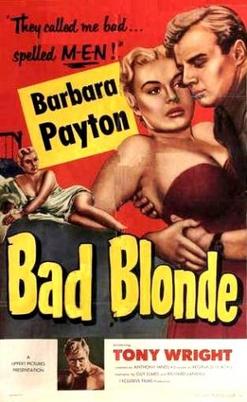Top Qs
Timeline
Chat
Perspective
The Flanagan Boy
1953 film by Reginald Le Borg From Wikipedia, the free encyclopedia
Remove ads
The Flanagan Boy (released in the United States as Bad Blonde) is a 1953 British second feature ('B')[3] film noir directed by Reginald Le Borg. It was made by Hammer Film Productions and stars Barbara Payton, Tony Wright, Frederick Valk and Sid James.[4] The screenplay was by Guy Elmes and Richard H. Landau based on the 1949 novel of the same name by Max Catto.[5][6] Jimmy Sangster was assistant director. Robert Lippert supplied Hammer with both an American director (Reginald LeBorg) and an American star (Barbara Payton). Filming began on Sept. 25, 1952 and finished on Oct. 19th, and the film was trade shown in the UK on June 20, 1953. It was released first in the US on April 10, 1953 (as Bad Blonde) and later in the UK in July, 1953. [7]
Remove ads
Plot
Shady promoter Sharkey spots young boxer Johnny Flanagan in a fairground booth fight and takes him under his wing, in an attempt to launch a comeback into prizefighting. He secures the backing of wealthy Italian Giuseppe Vecchi, but problems arise when Flanagan becomes romantically involved with Vecchi's wife Lorna. Falsely claiming to be pregnant with his child, Lorna persuades Flanagan to drown Vecchi and make it look like an accident. Vecchi's family arrives from Italy for the funeral, and his old mother acts as if she knows her son was murdered. Lorna later admits that the pregnancy was faked, and a guilt-ridden Johnny tells Lorna he's going to confess what they did to the police. Johnny is poisoned by Lorna, who makes it appear a suicide. Sharkey knows Lorna murdered Johnny and takes revenge on her, turning her over to the police.[8]
Remove ads
Cast
- Tony Wright as Johnny Flanagan
- Barbara Payton as Lorna Vecchi
- Frederick Valk as Giuseppe Vecchi
- John Slater as Charlie Sullivan
- Sid James as Sharkey
- Marie Burke as Mother Vecchi
- Selma Vaz Dias as Mrs. Corelli, Vecchi's sister
- Enzo Coticchia as Mr. Corelli

Production
It was the first film of note for Tony Wright. He was convincing as a fighter having been an amateur boxer in the British Navy and receiving coaching from Len Harvey, a former British heavyweight.[9][10]
Reception
In a contemporary reviews, Kine Weekly said "Exuberant murder melodrama, containing prominent sex overtones and a fight racket fringe. ... Elegant and apposite settings appropriately complete the rugged mixture of fisticuffs, romance and crime. A meaty dish, it's bound to go down with the crowd."[11]
Monthly Film Bulletin wrote "A lurid little melodrama, with toughly realistic portraits of boxing world characters, a solid performance by Frederick Valk as Vecchi, and Barbara Payton as a flashy sex-menace. Made in England by an American director, the film copies American 'B' models quite competently and unpleasantly."[12]
Variety wrote: "Lower-grade dualler toplining Barbara Payton. ... Footage is a hodge-podge of trite melodrama, unbelievable dialog and poor thesping."[13]
In British Sound Films: The Studio Years 1928–1959 David Quinlan rated the film as "average", writing: "Lurid stuff, quite strongly made."[14]
Leslie Halliwell called the film: "Competent British imitation of an American B movie."[15]
Remove ads
Retrospective appraisal
The Bad Blonde/Flanagan Boy's low-budget pedigree is evident, and attributable to Hammer studio's "draconian cost-consciousness," according film historian Wheeler W. Dixon.[16] Terming the film "a routine tale of murder and romantic betrayal" he adds:
The film might have been an interesting but obvious thriller, but was overlong, even at eighty minutes, and seems static and stagebound throughout its running time.[17]
Dixon merits Sid James, famous for his Carry On material, as "easily the best thing about the film."[18]
Remove ads
See also
Notes
References
External links
Wikiwand - on
Seamless Wikipedia browsing. On steroids.
Remove ads

